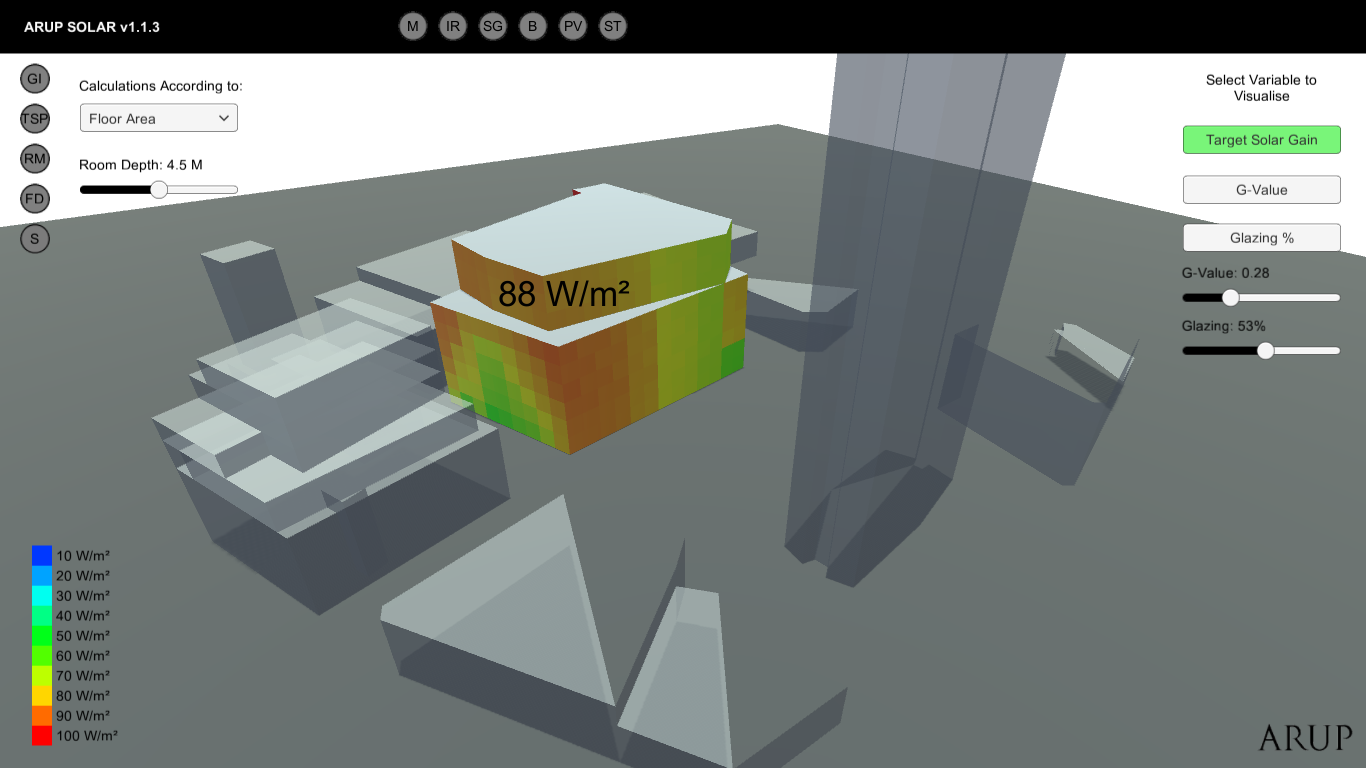Downloads
DOI:
https://doi.org/10.7480/jfde.2017.2.1739Keywords:
total architecture, software development, design toolAbstract
During early project stages, design teams need to explore a wide range of possible envelope configurations in order to identify those that best address the project constraints and objectives.
Crucial aspects such as control of solar gains, use of blinds and renewable energy production are typically the subjects of extensive discussions among architects and façade, mechanical, electrical and PH engineers. Traditional methodologies used to inform the design on such matters are neither flexible nor time efficient, failing to meet the expectations of the team. Arup Solar is an innovative APP developed to overcome such inefficiencies and to provide a user-friendly way to aid the discussion between architects and engineers. The validated APP aims to investigate the relationships between envelope features (e.g. window to wall ratio, g values, etc.) and cooling strategies, as well as identify potential opportunities for renewable solar energy production. It allows for the exploration of a large number of design options instantaneously, visualizing results by mapping them on the 3D model of the building. The process of building any instance of the APP includes a first step where the NURBs modeler Rhino/Grasshopper is utilized to run a Radiance & DAYSIM solar analysis on any complex geometry. The resulting data (on each surface mesh) is then exported to the Unity gaming engine, where a set of pre-programmed features is automatically implemented and the graphic interface is created. The outcome is a stand-alone parametric application that can be potentially run on any device.
How to Cite
Published
Issue
Section
License
Copyright (c) 2017 Mattia Donato, Giovanni Zemella, Gianluca Rapone, Jak Hussain, Conor Black

This work is licensed under a Creative Commons Attribution 4.0 International License.
Authors or their institutions retain copyright to their publications without restrictions.
References
Arup, O., (1970). The Key Speech. ARUP digital publication. Retrieved from: http://publications.arup.com/publications/o/ove_arups_key_speech
Autodesk®, (2010). Autodesk® Ecotect® Manual. Shading Masks. San Rafael (United States).
CIBSE, (2006). Technical Memorandum - TM 37, Design for improved solar shading control. London (United Kingddom). Retrieved from: http://www.cibse.org/Knowledge/knowledge-items/detail?id=a0q20000008I7elAAC
DiOrio, N., (2014). Technical Manual for the SAM Solar Water Heating Model. National Renewable Energy Laboratory (U.S. Department of Energy, Office of Energy Efficiency and Renewable Energy). Retrieved from: https://sam.nrel.gov/system/tdf/SimpleSolarWaterHeatingModel_SAM_0.pdf?file=1&type=node&id=69521
Duffie, J.A., Beckman, W.A., (2013). Solar Engineering of Thermal Process. John Wiley & Sons, Hoboken (New Jersey). Retrieved from: http://eu.wiley.com/WileyCDA/WileyTitle/productCd-0470873663.html
European Parliament, (2010) Energy Performance of Buildings Directive 2010/31/EU. Official Journal of the European Union. Retrieved from: eur-lex.europa.eu/LexUriServ/LexUriServ.do?uri=OJ:L:2010:153:0013:0035:en:PDF
Granadeiro V, et all. (2013). Building envelope shape design in early stages of the design process: Integrating architectural design systems and energy simulation. Elsevier, Automation in Construction. Retrieved from https://www.researchgate.net/publication/257371570_Building_envelope_shape_design_in_early_stages_of_the_design_process_Integrating_architectural_design_systems_and_energy_simulation
Greenberg, D., et al. (2013). Sustain: An experimental test bed for building energy simulation. Energy and Building. Retrieved from . //dx.doi.org/10.1016/j.enbuild.2012.11.026
Negendahl K, (2015). Building performance simulation in the early
design stage: An introduction to integrated dynamic models. Automation in Construction. Retrieved from: https://www.researchgate.net/publication/274736654_Building_performance_simulation_in_the_early_design_stage_An_introduction_to_integrated_dynamic_models
O’Hegarty, R., et al. (2016). Review and analysis of solar thermal facade. Elsevier, Solar Energy. Retrieved from: http://www.sciencedirect.com/science/article/pii/S0038092X16301852
Quaschning, V., (2016). Understanding Renewable Energy Systems. Routledge, New York (United States).
Skoplaki, E., et al. (2008). Operating Temperature of photovoltaic modules: A survey of pertinent correlations. Elsevier, Renewable Energy. Retrieved from http://www.sciencedirect.com/science/article/pii/S0960148108001353
U.S. Deparment of Energy. (2016). Energy PlusTM version 8.6 Documentation. Engeneering Reference. National Renewable Energy Laboratory (U.S. Department of Energy). Retrieved from: https://energyplus.net/documentation
Waibel, C. et all. (2016). Using Interpolation To Generate Hourly Annual Solar Potential Profiles for Complex Geometries. Proceedings of BSO 2016. Newcastle (United Kingdom). Retrieved from: http://www.ibpsa.org/?page_id=797
Zemella, G., et al. (2014). Evolutionary Optimisation of Façade Design. A New Approach for the Design of Building Envelopes. Springer-Verlag. London (United Kingdom). Retrieved from: http://www.springer.com/us/book/9781447156512
